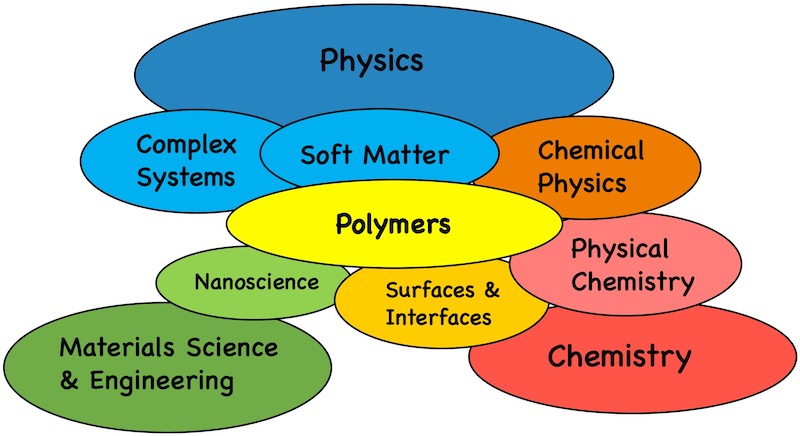Research Overview
Soft Matter Physics. Polymers. Experiments.
Soft Matter Physics is the study of physical systems that are strongly influenced by temperature and mechanical forces. These typically involve materials with complex many-body interactions such as polymers, liquids, liquid crystals, colloids, granular materials, and many biological systems. How molecular packing and conformations change with temperature arises from an interplay of entropic and enthalpic considerations defining available thermodynamic free energy minima. However, the dynamics of these complex systems can often be very slow such that the system spends most of its time kinetically trapped in non-equilibrium states.
Polymers are long chain molecules that frequently exhibit unique properties because of their macromolecular nature. Entanglements between these large polymer molecules leads to slow and complex dynamics, which means that polymers can easily become trapped in non-equilibrium states during processing and fabrication of materials. Polymers are ubiquitous in our lives. Synthetic polymers make up much of the objects we use in daily life (nylon, polyester, styrofoam, plexiglass), while natural polymers make up much of who we are (DNA, proteins, polysaccharides) and much of our natural world (cellulose, cotton, wood, paper). Understanding how polymer molecules behave in different environments, especially at nanoscale dimensions near interfaces, are fundamental to the behavior of many materials and to the development of new technologies.
Experiments are used to test our understanding of how systems behave. We want to understand the effects of forces, interfaces, and other perturbing influences on the properties of polymer materials.
Our lab’s approach to research is to develop and use unique experimental methods to study previously inaccessible phenomena in order to provide molecular-level insight into new and existing polymer materials. We frequently tackle long-standing issues in the field by developing a simplified sample geometry to address the phenomenon in question.
Over the years our research has focused on problems associated with polymer glasses, interfacial phenomena, polymer blends and miscibility. Below is a list of research topics our lab has worked on. Click on each link to learn more about our lab’s contributions to these topics.
-
Understanding coupled glass transition dynamics across polymer interfaces – Recent work from our lab has uncovered broad profiles in local Tg(z) across glassy-rubbery polymer interfaces demonstrating glass transition dynamics can become coupled between neighboring polymer domains over long distances. Current efforts are aimed towards understanding the cause of this unexpected phenomenon.
-
Impact of surface bound chains – We are working on understanding the unexpected large increases in local Tg(z) that occur next to surfaces with tethered chains. Grafted and adsorbed polymer chains are widely used to modify interfacial interactions in polymer materials and nanocomposites, but the underlying mechanisms by which this causes property changes to the neighboring polymer matrix are not well understood.
-
Developing nanoscale measures of local polymer properties – An ongoing focus of our lab is the development of new experimental methods to measure localized polymer properties at nanoscale dimensions in an effort to understand how their perturbed behaviors near interfaces are interrelated.
-
Nanoscale property changes in thin polymer films – Ongoing research in our lab is working to understand how various different material properties (glass transition temperature Tg, physical aging, refractive index and density, …) are altered in thin films, in particular at the local nanoscale level as a function of distance from interfaces.
-
Tuning miscibility of polymer blends with electric fields – Experimental results demonstrating electric fields enhance the miscibility of PS/PVME blends. By simply turning the electric field on and off, the blend can be repeatedly jumped from the one-phase to two-phase region at constant temperature.
-
Stress during vitrification impacts stability of polymer glasses – Using ellipsometry we have characterized how the physical aging rate β of glassy polymer films can be changed by the application of stress to the film during vitrification (thermal cooling) of the glass.
-
Polymers in art conservation – In collaboration with Chief Conservator Renée Stein at Emory’s Carlos Museum, our lab is characterizing polymers used in the preservation and restoration of artworks in an effort to understand how their preparation conditions impact their properties.
























